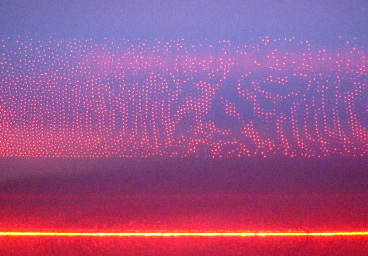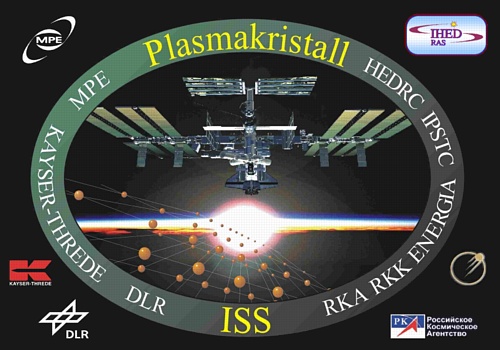|
|
 Plasma Crystals form under
certain conditions in a complex ('dusty') plasma.
There, the electrically
charged dust particles arrange in a regular macroscopic crystal
lattice. This allows
the investigation of the properties of condensed matter on the
most fundamental level, the kinetic one. This means that basic
processes, such as melting, can be followed by observing the motion
of individual particles. Since plasma crystals were discovered in
1994 the interest in this research area - in theory and
experimentally - has grown
exponentially.
Plasma Crystals form under
certain conditions in a complex ('dusty') plasma.
There, the electrically
charged dust particles arrange in a regular macroscopic crystal
lattice. This allows
the investigation of the properties of condensed matter on the
most fundamental level, the kinetic one. This means that basic
processes, such as melting, can be followed by observing the motion
of individual particles. Since plasma crystals were discovered in
1994 the interest in this research area - in theory and
experimentally - has grown
exponentially.The image to the right shows the sideview of a plasma crystal in the laboratory. Dust particles are suspended in an argon plasma above a high-frequency electrode (bottom). The horizontal field of view is 2 cm. (Enlarge.) If you touch the image with the mouse pointer you will see a top view of one crystal lattice. (Javascript must be activated.) Note the regular structure Gravity plays a crucial role for the structure of plasma crystals. In ground-based lab experiments mainly 2-dimensional crystals can be observed. This is due to the sedimentation of the micron-sized particles which build up the crystal. In microgravity big 3-dimensional plasma crystals can be grown. Therefore, our institute deals - besides ground-based lab research - with the investigation of plasma crystals under microgravity conditions, e.g. on parabolic flights and rocket experiments. In March 2001 the ''Plasmakristall-Experiment'' PKE-Nefedov of our institute - in collaboration with the Russian Space Agengy and the Institute for High Energy Densities (IHED, today: Joint Institute for High Temperatures, JIHT), Moscow - was the first scientific experiment to be flown on the International Space Station ISS. It was used in 45 successful complex plasma experiment sessions in microgravity and was decommisioned in 2005.  (The PKE logo contains external links to our collaboration partners) More Complex Plasmas in Space...
Since December 2005 the successor of PKE-Nefedov is onboard the International Space Station: PK-3 Plus. (Left image: Mission Patch ©MPE/MK. Click on the image to get a description.) It was operated for the first time by the Expedition 12 Crew (William McArthur, Valery Tokarev) in January 2006. For more on that see 'Latest News (2006)'. In the same year well-known German long-term astronaut Thomas Reiter performed Plasmakristall 3 Plus during two missions with three sessions each. PK-3 Plus is to continue the successful story of PKE-Nefedov. Many new features promise totally new results with a much higher accuracy, a deeper insight into the physics of complex plasmas. At MPE also the next-generation complex plasma experiment is under construction: PK-4. In contrast to PKE-Nefedov and PK-3 Plus, PK-4 uses a DC glow discharge to generate the plasma. Whereas the former experiments are optimized for plasma crystals, PK-4 will be ideal to study fluid dynamics on the kinetic level. It will be sent to the Space Station in 2014. ... and in the LabBesides the experiments in microgravity the MPE also works with numerous plasma chambers in ground based laboratories. There are a Para-Magnet Lab and a High-Field Lab where in the latter complex plasmas with magnetic fields up to 4 Tesla can be investigated. Plasma chambers with adaptive electrodes and striped electrodes allow to manipulate the particles by additional electric fields. Additionally, a thermophoresis chamber allows to study plasma crystals at various temperatures.Furthermore, a working group deals with the medical application of low temperature plasmas. In collaboration with a clinic in Munich they study the application of a plasma torch for the quasi-contactless sterilization of wounds.
→ Latest plasma crystal news: Click Here! |
||||||||
|
|